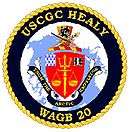USCGC Healy (WAGB-20)
_north_of_Alaska.jpg) | |
| History | |
|---|---|
| Name: | USCGC Healy |
| Namesake: | Michael A. Healy |
| Builder: | Avondale Shipyard |
| Laid down: | 16 September 1996 |
| Launched: | 15 November 1997 |
| Commissioned: | 10 November 1999 |
| Identification: |
|
| Motto: | Promise and Deliver |
| Status: | In service |
| Badge: |
|
| General characteristics | |
| Type: | Icebreaker |
| Displacement: | 16,000 long tons (16,257 t) |
| Length: | 420 ft (128 m) |
| Beam: | 82 ft (25 m) |
| Draft: | 29 ft 3 in (8.92 m) |
| Installed power: |
|
| Propulsion: |
|
| Speed: |
|
| Complement: |
|
| Aircraft carried: |
|
| Notes: | 5 laboratories: Main Lab, Wet Lab, Bio-Chem Lab, Electronics Lab, Meteorological Lab |
USCGC Healy (WAGB-20) is the United States' largest and most technologically advanced icebreaker.[1] She is classified as a medium icebreaker by the U.S. Coast Guard.[1] She is homeported in Seattle, Washington and was commissioned in 1999. On September 5, 2015, USCGC Healy became the first unaccompanied United States surface vessel to reach the North Pole. The current Commanding Officer is Captain Jason Hamilton. Captain Hamilton assumed command of Healy in May, 2015.[2]
Construction
Healy was built by Avondale Industries in New Orleans, Louisiana. The construction included a technology transfer agreement between Avondale Industries and the Finnish Kværner Masa-Yards Arctic Technology Centre, where the latter provided expertise for hull form development and propulsion line engineering based on the Finnish diesel-electric icebreaker Otso.[3]
Healy is named in honor of United States Revenue Cutter Service Captain Michael A. Healy. Her keel was laid on 16 September 1996. Healy joined the icebreakers USCGC Polar Star (WAGB-10) and USCGC Polar Sea (WAGB-11) in their homeport of Seattle, Washington on 10 November 1999. The ship departed New Orleans on January 26, 2000, performing sea trials off of San Juan, Puerto Rico, and in Baffin Bay between Canada and Greenland. She arrived in Seattle on 9 August 2000 after transiting the famed Northwest Passage and was placed "In Commission, Active" on August 21, 2000.[4]
Design

USCGC Healy is an optimally manned vessel, meaning she has the minimum number of personnel staffed in order to safely navigate.[5] Due to the vast array of missions conducted by Healy, it is vital that crewmembers are fully qualified on a number of duties.[6] Healy operates two A-Frames, one on the aft working deck and one on the starboard side. There are two articulated cranes on the aft working deck, with the starboard side rated to 15 short tons (14 t) and the port side rated to 5 short tons (4.5 t). The aft working deck provides ample space to conduct science and research operations. Healy has a forecastle crane with a load capacity of 3 short tons (2.7 t), and two 04 level cranes with load capacities of 15 tons each.[7] Healy has a Dynamic Positioning System (DPS) that uses its Bow Thruster system, which aids in navigation and station keeping during science operations.[8] Its flight deck is capable of landing both of the Coast Guard's helicopter airframes, and attached is a hangar that can house 2 HH-65 helicopters. Healy can accommodate 8 ISO vans on the ship, which are used as science labs and workstations.[9] Healy has three small boats on board. One is the 38 ft (12 m) Arctic Survey Boat (ASB), which is on the starboard side. Healy has two 26 ft (7.9 m) Cutter Boat Large (CBL) Rigid Hull Inflatable Boats (RHIB), one on each side.[10]
Capabilities
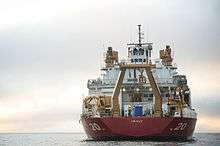

Designed to conduct a wide range of research activities, Healy provides more than 4,200 square feet (390 m2) of scientific laboratory space, numerous electronic sensor systems, oceanographic winches, and accommodations for up to 50 scientists. Healy is also designed to break 4.5 ft (1.4 m) of ice continuously at 3 knots (5.6 km/h; 3.5 mph) or ice 10 ft (3.0 m) thick when backing and ramming, and can operate in temperatures as low as −50 °F (−46 °C).
As a Coast Guard cutter, Healy is also a platform for supporting other potential missions in the polar regions, including: search and rescue, ship escort, environmental protection, and enforcement of laws and treaties.
Notable Operations
October 29, 2015: USCGC Healy received the Coast Guard Unit Commendation award for exceptionally meritorious service from 24 June to 29 October 2015 during their Arctic West Summer 2015 deployment.[11] Healy traveled over 16,000 miles, took over 25,000 water and ice samples from 72 science stations, and became the first unaccompanied U.S. surface vessel to reach the North Pole. She also engaged with the crew of the German icebreaker Polarstern while at the North Pole in support of the international scientific mission Geotraces. Finally, Healy became the first vessel to broadcast a live feed from ice-bound Arctic waters, streaming video of a search and rescue exercise to shore-based coordinators.[12]
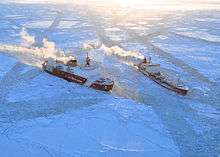
April 10, 2012: USCGC Healy received the Coast Guard Unit Commendation award for exceptionally meritorious service from 3 January to 5 February 2012 after she escorted a tanker carrying a critical load of fuel through tremendously difficult winter ice conditions to Nome, AK. In November 2011, a strong winter storm struck western Alaska, which prevented a vital fuel delivery to Nome. Healy delayed her return home from a six-month Arctic deployment in order to escort the Russian-flagged tanker MT Renda to Nome, AK. Healy escorted the MT Renda through over 300 miles of extremely difficult ice conditions and broke out the beset ship time after time. After many days of great exertion, MT Renda transferred the fuel to Nome over the course of three days. On 20 January, Healy began the break out for herself and the MT Renda. They emerged from the ice on 29 January 2012 after successful completion of the mission. This was the first-ever winter fuel delivery from the water in Western Alaska.[13]
January 20, 2010: USCGC Healy received the Coast Guard Coast Guard Meritorious Unit Commendation award for meritorious service from 6 August to 16 September 2009 while conducting the Joint U.S.—Canada United Nations Convention on the Law of the Sea Extended Continental Shelf Mapping Expedition. In collaboration with CCGS Louis S. St-Laurent, Healy pushed 150 nautical miles further north than planned and avoided $2.4 million in future expedition mapping costs. Healy also acquired over 1,000 pounds of valuable geological samples by conducting dredging operations at depths of up to 3 miles. The rare samples were essential in establishing the origin of the targeted extended continental shelf.
July 16, 2008: USCGC Healy received the Coast Guard Coast Guard Meritorious Unit Commendation award for meritorious service from April 2007 to July 2008 while conducting science operations in support of national scientific, economic, and political interests. Healy conducted a multi-year project in order to evaluate the entire ecosystem of the Bering Sea. Data collected during these missions helped improve the understanding of food webs and biological communities in the Arctic. Through superior mission execution in adverse weather, Healy exceeded expectations significantly.[14]
May 7, 2003: USCGC Healy received the Coast Guard Unit Commendation award for exceptionally meritorious service from January 2003 to April 2003 while conducting Operation Deep Freeze in support of the U.S. Antarctic Program. With less than three weeks' notice, Healy was deployed to Antarctica in support of the critical annual re-supply of McMurdo Station. Healy played an instrumental role in coordination with USCGC Polar Sea in resupplying the ice station. Healy successfully escorted the freighter American Tern and the tanker Richard G. Matthieson. Healy successfully escorted both ships in and out of the ice, and facilitated the delivery of resources to McMurdo Station
January 23, 2002: USCGC Healy received the Coast Guard Coast Guard Meritorious Unit Commendation award for meritorious service from 12 June 2001 to 21 December 2001 during the Arctic East 2001 Science Mission. Healy mapped 1,100 miles of the Gakkel Ridge, previously the only unmapped undersea ridge in the world. Twelve previously unknown volcanoes and numerous undersea hydrothermal vents were discovered. Eight tons of rock samples were taken from over 100 deep sea dredges.
Recent Operations

2016: On October 15, 2016, USCGC Healy returned to her home port in Seattle, Washington after a 127-day summer deployment in the Arctic Ocean. The crew of the USCGC Healy and her accompanying scientists participated in three scientific studies. Highlights of this deployment include the discovery of new species of jellyfish in the Chukchi Sea, observations of the continental shelf in the Arctic Ocean and Bering Sea, and data collection on climate change.[15]
2015: On September 5, USCGC Healy became the first unaccompanied United States surface vessel to reach the North Pole.[11] Healy travelled over 16,000 nautical miles during Arctic West Summer 2015 (AWS15). During this expedition, more than 25,000 water and ice samples from 72 science stations were collected through Conductivity, Temperature, Depth (CTD) casts and on-ice science stations.[12] USCGC Healy worked with both the United States Coast Guard Research & Development Center and the National Oceanic and Atmospheric Administration to test and develop Unmanned Aerial Vehicles (UAV's), and became the first vessel to broadcast a live feed from Arctic waters. Healy also conducted a professional international engagement with the German Icebreaker Polarstern at the North Pole.[16] It was a historic Arctic deployment that displayed the Coast Guard’s unique polar capabilities to the public and the world. Between May and October 2015, Healy also tested the Mobile User Objective System (MUOS) high frequency satellite communication system throughout its Arctic Summer West 2015 mission. Successful tests were completed throughout the expedition during the transit to the North Pole.
2014: A main area of focus during Arctic West Summer 2014 (AWS14) was the study of phytoplankton blooms along the Chukchi Sea.[17] Healy also worked in conjunction with the United States Coast Guard Research and Development Center to test Aerostat balloons, Unmanned Aerial Vehicles (UAV's), Autonomous Underwater Vehicles (AUV), Remotely Operated Vehicles (ROV), and oil tracking buoys.[18]
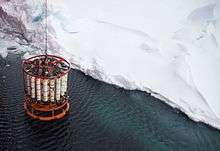
2013: Arctic West Summer 2013 (AWS13) consisted of four different missions for Healy, over which more than 19,000 miles were covered. The first mission utilized Healy's unique over-the-side science capabilities in order to collect organisms and create an ecological picture of the Hanna Shoal region. The second mission yielded sediment samples from the Mackenzie River Basin through the use of coring devices. For the third mission the Coast Guard Research Development Center, in coordination with the National Oceanic and Atmospheric Administration, deployed numerous equipment for testing and development. The fourth and final mission deployed subsurface moorings and conducted numerous Conductivity, Temperature, Depth (CTD) tests to study the Alaskan Boundary Current.[19] A group of researchers from the Naval Submarine Medical Research Laboratory tested their Submarine Team Behaviors Tool with the Healy crew in September 2013. They were part of the 50 person science team from the USCG Research and Development Center[20] that evaluated technology for the recovery of "simulated oil trapped in or under ice at the polar ice edge".[21]
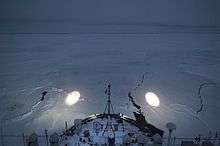
2012: In January 2012, Healy escorted the Russian-flagged freighter Renda through pack ice to deliver an emergency supply of fuel to Nome, Alaska. Such a winter delivery had never been attempted before because the ice floes are 1 to 5 feet (0.30 to 1.52 m) thick during the winter season.[22] The resupply was vital to the city, and was the first-ever winter fuel delivery from the water in Western Alaska.[23] Over the course of Arctic West Summer 2012 (AWS12), Healy travelled over 18,000 nautical miles and conducted 687 science casts. Healy also added 25% more data to the bathymetric mapping project of the extended continental shelf through multibeam sonar bottom-mapping.[24] This data was collected in support of the delineation of the American and Canadian continental shelves.[25]
2011: During Arctic West Summer 2011 (AWS11), Healy collaborated with researchers from NASA to study the refractive properties of sunlight in the Arctic.[26] USCGC Healy spent the summer mapping the Extended Continental Shelf in collaboration with the CCGS Louis S. St-Laurent. A third mission of this patrol studied organic carbon and its levels in the Arctic water column. This data was used to explain bacteria distribution in the water column as well as carbon dioxide and biomass cycles.[27]
Dive Mishap
On August 17, 2006, Lieutenant Jessica Hill and PO2 Stephen Duque died of unspecified causes during diving operations in the Arctic Ocean. The Coast Guard conducted simultaneous safety and administrative investigations the results of which were made public in January 2007[28][29] along with a Final Decision Letter dated August 23, 2007.[30]
Initial press reports indicated that the divers were conducting an inspection of the rudder - a routine operation - at the time of the accident, but later reports stated that the two were doing a cold-water training dive near the bow of the ship. The dive was reported to have been planned for a maximum depth of 20 feet (6 m). Lieutenant Hill's father, citing autopsy reports, has indicated that his daughter actually reached a depth of near 200 feet (61 m) in what he described as an out of control descent. The divers were tended by unqualified and poorly-instructed personnel on the surface, none of whom were familiar with cold water diving or scuba diving in general.[31] It is not clear why they extended so much line to the divers. By the time the two could be pulled to the surface, gas reserves were empty and neither diver could be revived.[32]
On August 30, Commanding Officer Captain Douglas G. Russell was temporarily relieved of command by Vice Admiral Charles Wuster citing a "loss of confidence" in Russell's ability to command.[33] The relief was later made permanent by Coast Guard Commandant Admiral Thad Allen. Russell was initially replaced by Captain Daniel K. Oliver, the previous Healy Commanding officer who Russell had relieved only two months earlier. Oliver returned to his regular staff job a short time later, when Captain Ted Lindstrom was named the new commanding officer. Lindstom has commanded four previous Coast Guard cutters, and was Chief of Response for the Coast Guard's 13th District in Seattle, Washington prior to returning to sea.[34]
Awards and honors
US Coast Guard E Ribbon for the period of 4 February 2012 to 19 November 2014, at Afloat Training Organization (ATO) Everett, Washington.
References
- 1 2 "USCGC HEALY". CGC HEALY. 24 May 2015. Retrieved 7 December 2015.
- ↑ "CGC Healy Command". CGC HEALY. 8 October 2015. Retrieved 7 December 2015.
- ↑ Strong Finnish involvement in U.S. icebreakers. Navigator Yearbook 1/2016, page 20.
- ↑ "CGC HEALY History". CGC HEALY. Retrieved 7 December 2015.
- ↑ Klingenberg, Jonathan (20 September 2015). "Counting Quals". Coast Guard Alaska. USCG. Retrieved 7 December 2015.
- ↑ "CGC HEALY's ship characteristics". CGC HEALY. 19 September 2015. Retrieved 7 December 2015.
- ↑ "Cranes". icefloe.net. Retrieved 7 December 2015.
- ↑ "Navigation Equipment". icefloe.net. Retrieved 7 December 2015.
- ↑ "Vans". icefloe.net. Retrieved 7 December 2015.
- ↑ "Small Boat Support". icefloe.net. Retrieved 7 December 2015.
- 1 2 Norcross, Amanda. "CGC Healy crew receives Unit Commendation award". DVIDS. Retrieved 8 December 2015.
- 1 2 Smith, Laurin. "October 29, 2015". CGC HEALY. Retrieved 8 December 2015.
- ↑ "Seattle based ice breaker crew presented Coast Guard Unit Commendation award". U.S. Coast Guard Newsroom. Retrieved 8 December 2015.
- ↑ Schendorf, Tara. "August 12, 2008". CGC HEALY. Retrieved 8 December 2015.
- ↑ Haviland, Dave (17 October 2016). "Coast Guard Cutter Healy Returns to Homeport, After 127-Day Deployment in Arctic Ocean - Newstalk KBKW".
- ↑ Smith, Laurin. "September 9, 2015". CGC HEALY. Retrieved 8 December 2015.
- ↑ "HLY1401 Cruise Report" (PDF). icefloe.net. Retrieved 8 December 2015.
- ↑ Mahoney, Carolyn. "August 26, 2014". CGC HEALY. Retrieved 8 December 2015.
- ↑ "2013 Final Cruise Report" (PDF). icefloe.net. Retrieved 8 December 2015.
- ↑ "USCG: Research, Development, Test and Evaluation". uscg.mil.
- ↑ Pinto, Maria D (2013-10-24). "NSMRL: At the top of the world". The Dolphin. Retrieved 2013-10-24.
- ↑ "Coast Guard Helping Icebreaker Reach Fuel-Stricken Alaska City". Fox News. Associated Press. 8 January 2012. Retrieved 2012-12-20.
- ↑ Weisburger, Alison. "Lessons From the Russian Fuel Tanker Resupply of Nome, Alaska". The Arctic Institute. Retrieved 7 December 2015.
- ↑ "AWS12 Cruise Report" (PDF). icefloe.net. Retrieved 8 December 2015.
- ↑ Sheridan, Erin. "November 8, 2012". CGC HEALY. Retrieved 8 December 2015.
- ↑ "Departing Seattle AWS11" (PDF). CGC HEALY. Retrieved 8 December 2015.
- ↑ "November 28, 2011". CGC HEALY. Retrieved 8 December 2015.
- ↑ Allen, Thad W. (12 January 2007). "USCG Commandant's Statement" (pdf). Retrieved 2012-12-20.
- ↑ Allen, Thad W. (10 January 2007). "Final Action Memorandum" (pdf). Retrieved 2012-12-20.
- ↑ Papp, Robert J, Jr (23 August 2007). "Final Decision Letter" (pdf). Retrieved 2012-12-20.
- ↑ Kime, Patricia (12 January 2007). "CG report cites multiple failures in diving deaths". Navy Times. Retrieved 2012-12-20.
- ↑ Karlinsky, Neal (22 November 2006). "200-Foot Plunge Killed Coast Guard Divers". ABC News. Retrieved 2007-10-20.
- ↑ Barber, Mike (31 August 2006). "Coast Guard skipper out over 2 diving deaths". Seattle Post-Intelligencer. Retrieved 2007-10-20.
- ↑ Johnson, Gene (30 August 2006). "New Healy captain named after deaths of 2 Coast Guard divers". Seattle Post-Intelligencer. Associated Press. Retrieved 2007-10-20.
External links
| Wikimedia Commons has media related to USCGC Healy (WAGB-20). |
